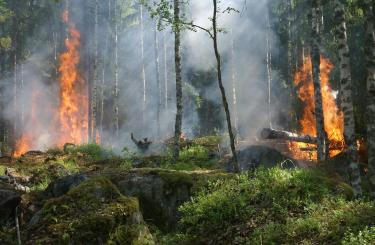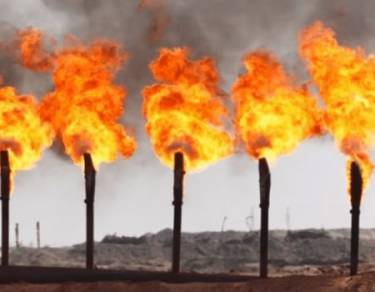Shale Oil & Tar Sands: Like Trying to Burn Rainforest

Extracting shale oil is like trying to burn rainforest to harvest soggy charcoal. Just as fracked shale wells are initiated with explosives and a high pressure slurry of water, chemicals, and thousands of tons of sand, so too are the fires in our analogous lush forest ignited by an expensive cocktail of gasoline, chemicals, and tinder. Just as fracked wells deliver an initial high volume flow before declining precipitously, so too our gasoline-kindled rain forest fires briefly yield copious charcoal before diminishing to a smolder.
Companies must continually set new fires for ongoing charcoal harvest, but since they sensibly burned the driest pockets of forest first, new fires are ever less productive. The companies reignite early patches, hoping the trees missed by the first fire can yield more charcoal than would virgin sodden patches—but there isn’t much wood left in the burnt over areas. Worse, as with frac hits in shale oil fields, auxiliary burns interfere with the still smoldering burn piles, reducing charcoal output.
The steady supply of charcoal impresses credulous media, politicians, financial markets, and the general public, but the companies invest so much energy into operations that they extract little net energy. The industry never makes a profit. Companies sink ever deeper into debt as they borrow more money to keep the forests burning.
Trying desperately to attract new investments to prolong their money-losing scheme, the companies extract charcoal as quickly as possible. In their haste to maximize short-term volume, they make inefficient use of the resource, burning off tree limbs without attempting to harness their energy. They flood the market with so much product at once that it sells at a discount, and the excess must be shipped thousands of miles overseas.
This economic boondoggle degrades a giant pool of life-nurturing, safely sequestered carbon into deadly planet-heating gas. In the process, soot drifts and chemicals leach, toxifying surface and ground water. Roads and fires fragment and destroy habitat, reducing biodiversity to ash. Flaming gasoline and tinder add to the carbon load as the denouements of their own stories of damaging extraction, processing, and transport.
In the tar sands, mud slides buried our analogous rain forest, so companies dig up waterlogged trees before burning them. Though they needn’t endlessly ignite new fires, the enterprises make large up-front investments in earth moving and tree processing machinery, then pay ongoing mining and processing costs.
The companies continually claim that efficiency and technology improvements will soon make them profitable, but the bottom line is that rainforests just don’t burn well.
Peak oil is here
Exploitation of shale and tar sands confirms that industrial society has exhausted its stores of easy energy. Peak oil is here. Tragically, far from mobilizing an aggressive shift towards sustainability, it reveals us as energy addicts desperately pursuing even the dirtiest, most destructive and marginal resources.
We can’t wait for peak oil to end fossil fuel combustion; we must proactively shut down the flows. We might start by extinguishing the dying fire of shale oil.
Consider supporting our work by joining our mailing list below, sharing & "liking" this page, and following us on social media. You may freely republish this Creative Commons licensed article with attribution and a link to the original.
